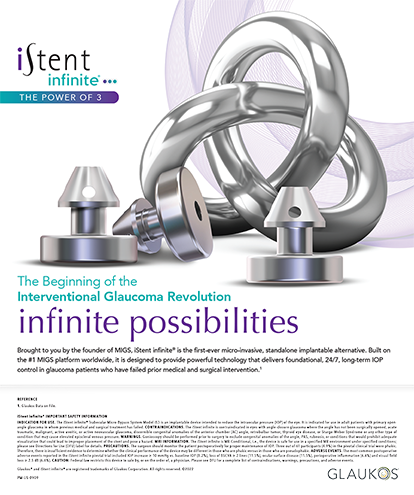You have participated in a number of research projects during your 20 years in practice. Which do you feel were most significant? My role in commercializing Celluvisc (Allergan, Inc., Irvine, CA) certainly ended up touching the most lives. Proving an artificial tear could be therapeutic was quite novel. In addition to demonstrating the reversal of squamous metaplasia, we also changed the way in which eye doctors practice. The grab-bag use of toxic, preserved multi-dose tears was replaced by the selection of specially formulated, anionic, unit-dose vials. The Celluvisc formulation went on to become the world's leading artificial tear.
What are your research interests today? Not a day goes by without my contemplation of how to help patients with post-RK syndrome. Finding a safe, effective surgical treatment for hyperopia, fluctuation, and irregular astigmatism is a big challenge. The Grene Lasso works, but this procedure is technically challenging and temporary. I am currently studying mitomycin C-enhanced PRK, and the early results are excellent. I feel this path will lead to wavefront-driven, customized surface ablation and significantly improved vision quality. It is exciting to help those patients from decades ago who did not have the benefit of today's advanced technologies.
What prompted you to write a textbook on comanagement? My dad was a small town doctor, and I actually began practice as a general practitioner. Having seen medical care from the primary care perspective, I wanted to explore the importance of coordination between optometrists and refractive surgeons. The book is entitled Patient Centered Comanagement, and I think comanagement has matured to fit this description. The political and economic influences have diminished, and most comanagement arrangements start with “what's best for the patient?” The 3-year lull in refractive surgery has led to a de-emphasis on comanagement within many practices, but soon refractive surgery results will begin to equal or exceed those of spectacles or contacts. This will fuel new growth of refractive surgery and once again bring comanagement issues to the fore.
You have spoken and written about practice structure and management. How does your practice compare to your theoretical model? Fifteen years ago, Paul Starr, a sociology professor at Princeton University, wrote about the impending domination of medical practice by vertically and horizontally integrated corporations. I have spent the last 13 years building an integrated practice—but without the corporation. Grene Vision Group is a traditional, doctor-owned group practice that exemplifies the best attributes of a regional scale combined with a balance between doctors' autonomy and accountability. My participation in the ongoing evolution of our group has been the most important creative project of my professional life. With 12 ophthalmologists, 21 optometrists, 275 staff members, and 19 locations, it is certainly the biggest project as well.
What has been the most interesting aspect of your 2 decades in refractive surgery? During that time, refractive surgery has grown from its infancy into a global business and true medical subspecialty. It has been a thrill and a privilege to go along for the ride. Today, as refractive surgery is poised to enter its third period of growth (following the Casebeer and LASIK eras), it is appropriate to recognize that we stand on the shoulders of all those men and women who held a constant and passionate conviction about the future of refractive surgery. That future is here, and I am excited to be a part of it. As productive as the past 2 decades have been, the best and most productive era still lies ahead.


